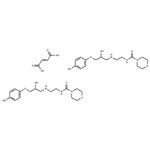Xamoterol fumarate is a cardioselective partial beta-agonist, the first of its class to be
developed for use in heart failure. The main advantage of xamoterol fumarate as a
cardiotonic lies in the fact that its beta-blocking effect exerted during high sympathetic
drive will protect the heart from overstimulation. It is claimed to be a viable but safer
alternative to digoxin.
Xamoterol is a partial agonist of β1-adrenergic receptors (β1-ARs) with an EC50 value of 80 nM for the generation of cyclic AMP (cAMP) in neonatal rat cardiomyocyte cultures. It increases spontaneous contraction of isolated rat right atria (EC50 = 4.67 nM). In vivo, xamoterol increases heart rate in beagle dogs (ED50 = 3.2 μg/kg) and in a rat model of spontaneous heart failure (ED50 = 6 μg/kg), an effect that is reversed by the selective β1-AR antagonist betaxolol but not the selective β2-AR antagonist ICI 118551 . Formulations containing xamoterol have been used in the treatment of heart failure.
Xamoterol Hemifumarate, is a β1-adrenoceptor-selective partial agonist.
β 1 -adrenoceptor-selective partial agonist (pA 2 values are 7.4-7.8 and 5.2-6.2 at β 1 - and β 2 -adrenoceptors respectively).

